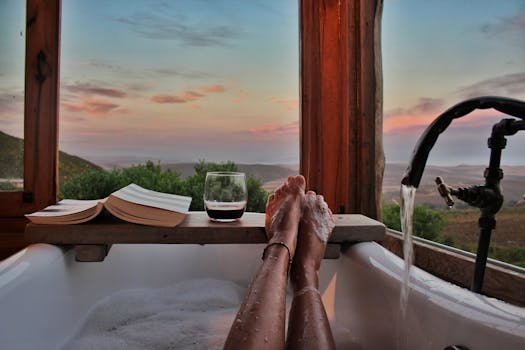Curative Baths: A Natural Path to Healing and Renewed Vitality
Curative baths represent one of the most ancient and instinctive forms of natural medicine, a powerful modality for healing and revitalization that modern science is only now beginning to quantify. In our search for complex solutions to fatigue, stress, and inflammation, we often overlook the profound healing potential of water. This isn’t about a hurried scrub for cleanliness; it’s about a deliberate, therapeutic practice that taps into the body’s innate wisdom. Inspired by the work of natural health pioneer Edwin J. Ross, this guide will illuminate how you can harness the transformative power of hydrotherapy to combat stress, renew your energy, and unlock a more resilient version of yourself, all from your own bathroom.
What Is Hydrotherapy? The Instinctive Power of Curative Bathing
Hydrotherapy, the therapeutic use of water, is the foundational principle behind curative baths. It’s a practice as old as life itself, observed in the animal kingdom long before it was formalized by human medicine. A deer pausing during a chase to cool its underside in a stream or a bear plunging into a lake on a hot day are not merely cleaning themselves; they are engaging in an instinctual act of thermoregulation and inflammation control. Ross argued that humans possess this same innate drive. When we follow this instinct—focusing water and massage on the core pelvic region—we engage in a form of hydrotherapy that stimulates our most vital systems.
The power of this practice is supported by modern research on balneotherapy, the study of baths, especially in natural mineral waters, for healing. A scientific review on the biomedical effects of balneotherapy confirms that water-based therapies can induce significant physiological changes, including improvements in circulation and modulation of the immune system. This scientific evidence validates what natural healers have long professed: intentional water therapy is a potent tool. By moving beyond simple immersion and incorporating targeted techniques, we transform a daily routine into a powerful curative bath that supports the body’s elimination pathways and calms the nervous system.
The Natural Bath: Edwin J. Ross’s 5-Minute Method
At the heart of Ross’s philosophy is the “Natural Bath,” a specific technique designed to be both profoundly effective and incredibly efficient. Unlike lengthy soaks that can be enervating or harsh cold plunges that shock the system, this method is a brief, stimulating, and comprehensive practice. Ross developed this approach by observing the most natural and effective ways both animals and humans interact with water when left to their own devices. The result is a routine that combines cleansing, massage, and circulatory exercise into a single, powerful five-minute ritual.
The brilliance of Ross’s Natural Bath lies in its focus on the pelvic region, which houses critical organs of elimination and reproduction, all densely interconnected with the autonomic nervous system. By directing therapeutic stimulus to this area, the bath creates a cascade of benefits throughout the entire body. This targeted approach is a form of nervous system regulation, helping to tone overstimulated nerves and bring the body back into a state of balance. For those seeking natural remedies for stress, this method offers a direct, synthetic drug-free pathway to calm by addressing the physical seat of much of our tension and anxiety.

Step-by-Step Guide: How to Perform the Natural Bath
Ready to experience the benefits for yourself? This actionable guide will walk you through performing Edwin J. Ross’s Natural Bath. The entire process takes only five minutes, making it an easy addition to your morning or evening routine.
Step 1: Preparation. Fill your bathtub with just 3 to 4 inches of cool water. The temperature should be invigorating but not unpleasantly cold; tepid to cool is ideal, especially when starting out. The goal is stimulation, not shock. Position yourself sitting in the tub with your knees raised, allowing you easy access to your entire lower body.
Step 2: The Process (5 Minutes Maximum). Begin by vigorously splashing water and massaging your toes and feet with your hands. Work your way up your legs, using a brisk, kneading motion to stimulate blood flow. Then, focus intently on the pelvic region—the groin, lower abdomen, and anus—splashing and massaging this area thoroughly. This direct stimulation is key to awakening the elimination organs and toning the local nerves. Finally, use your water-covered hands to massage your arms, chest, back, and abdomen, ensuring your entire body receives the invigorating effects of the water and touch.
Step 3: Drying and Aftercare. For the maximum stimulating effect, Ross recommends drying your body using only your bare hands, effectively giving yourself a final, friction-based massage. If time permits, spend 5-10 minutes air-drying in a warm room. You will be left feeling invigorated, alert, and clean, with a sense of renewed vitality that carries you through your day. This practice is one of the most accessible natural remedies for stress and low energy, requiring no special equipment—just a few minutes of your time and intention.
Cold Showers vs. Curative Baths: Why Intensity Isn’t Always Better
The cold shower is often touted as the pinnacle of hydrotherapy, a test of willpower that promises immense health rewards. While it certainly provides a jolt, Ross and other natural health advocates caution that this intensity can be counterproductive. The sudden, all-over deluge of cold water is a massive shock to the nervous system. For many, this creates a stress response that can be more damaging than beneficial, especially for those already dealing with adrenal fatigue or a heightened state of nervous system regulation.
In contrast, the self-administered curative bath provides all the circulatory and nervous system benefits without the punishing shock. As Ross notes, “It is easier to get into two or three or even four inches of cool or tepid water than it is to get under the deluge of cold water striking everywhere almost at once.” When you use your hands to apply the water, you combine the cool temperature with the warmth of your touch and the action of massage. This creates a gentle yet powerful stimulus that the body can process and benefit from, rather than just endure.
The goal of true hydrotherapy is healing, not heroism, and the gentle approach of the Natural Bath is often more sustainable and effective in the long run.
The Proven Benefits of Incorporating Curative Baths into Your Routine
Making curative baths a consistent part of your wellness regimen can yield a remarkable array of benefits that extend far beyond simple cleanliness. This practice offers a holistic tune-up for your entire mind-body system. The research into hydrotherapy and related practices provides a strong foundation for these claims, showing how water-based treatments can be a powerful tool for managing modern health challenges.
First, this practice is a powerful tool for nervous system regulation. The combination of cool water and focused massage tones the vagus nerve and calms the sympathetic (fight-or-flight) nervous system. This is crucial for managing the effects of chronic stress, which you can learn more about in our article on understanding and managing nervousness with natural remedies.
Furthermore, the vigorous rubbing and temperature change dramatically improve circulation, ensuring oxygen-rich blood reaches all your tissues and organs. This enhanced blood flow, combined with the direct stimulation of the skin—your body’s largest organ of elimination—supports the body’s natural detoxification processes, helping to clear metabolic waste.
The benefits continue with a notable reduction in systemic inflammation. The cool water and improved lymphatic flow help soothe inflammatory processes, providing relief for aching muscles and joints. A study published in the National Library of Medicine on cold-water immersion after exercise found it effectively reduced muscle soreness, validating this age-old practice.
Finally, regular practice of this form of hydrotherapy builds long-term resilience. Your body becomes better adapted to handle temperature changes, physical stress, and mental fatigue, leaving you feeling stronger, more balanced, and vitally alive. By dedicating just five minutes a day to this practice, you invest directly in your sustained energy and well-being, proving that some of the best natural remedies for stress are also the simplest.
Your Path to Vitality Starts Here
Curative baths are more than a historical footnote; they are a practical, powerful, and profoundly accessible form of hydrotherapy that can be seamlessly integrated into modern life. By embracing Edwin J. Ross’s Natural Bath method, you choose a path of gentle strength over punishing intensity, aligning with your body’s innate instincts for healing. The rewards are clear: a calmer nervous system, robust circulation, reduced inflammation, and a deep, sustainable well of energy. There is no benefit in punishing the body unduly when such a simple, effective, and natural path to renewal is readily available. Your journey toward renewed vitality is just one bath away.
FAQ
What is the most effective type of curative bath for beginners?
The most effective and beginner-friendly method is Edwin J. Ross’s 5-Minute Natural Bath. Unlike intense cold plunges, it avoids systemic shock by using a small amount of cool water combined with self-massage. This gentle approach makes it easy to stick with, allowing you to consistently reap the benefits of improved circulation and nervous system regulation without the dread. It’s the perfect entry point to experiencing the transformative power of hydrotherapy.
Can curative baths genuinely help reduce stress and anxiety?
Yes, absolutely. Curative baths are a powerful form of hydrotherapy that directly calms the nervous system. The focused massage and cool water on the pelvic region, a key area for nerve bundles, stimulates the vagus nerve. This triggers the body’s “rest-and-digest” mode, effectively reducing cortisol levels and alleviating feelings of stress and anxiety. Making it a daily routine builds resilience, helping you maintain a sense of calm and balance throughout your day.
